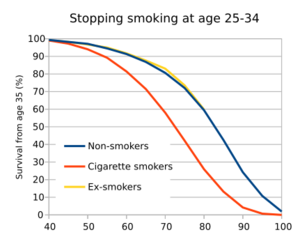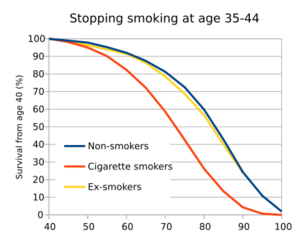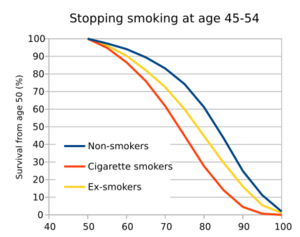British Doctors Study facts for kids
The British Doctors' Study was a very important research project that lasted for 50 years, from 1951 to 2001. It helped prove that smoking tobacco makes people much more likely to get serious diseases like lung cancer. This study changed how we understand the dangers of smoking.
Contents
Why This Study Was Important
For many years, people didn't fully understand the dangers of smoking. Some advertisements even made smoking seem healthy. Doctors and scientists knew that lung cancer rates were going up. But they didn't have clear proof that smoking was the cause.
To find out more, the Medical Research Council in the UK decided to start a special study. They used a new way of doing medical research called a prospective study. This means they would follow a group of people over a long time. They would watch what happened to their health. This was a new and exciting way to answer big health questions.
When the study's first results came out in 1956, they were a big deal. They showed how important it was to use science to understand public health. Most importantly, the study clearly linked smoking tobacco to many serious diseases.
How the Study Was Done
The study began in October 1951. Researchers sent letters to all doctors in the United Kingdom. About two-thirds of them, over 40,000 doctors, agreed to take part. No new people joined the study after this first group. Most of the study focused on male doctors because there were fewer female doctors in the group.
The researchers kept track of these doctors for many years. They asked them about their health and smoking habits. They sent out new questionnaires in 1957, 1966, 1971, 1978, 1991, and finally in 2001. By following them for so long, the scientists could see how smoking affected their health over time.
What the Study Found
It's hard to say exactly how much the study changed things right away. In the 1950s, smoking wasn't seen as a big public health problem. But over the next few decades, people started to understand the dangers more.
The British Doctors' Study gave strong proof that smoking was linked to many serious health problems. It showed that smoking caused:
- Lung cancer
- Heart attacks (myocardial infarction)
- Breathing problems (respiratory disease)
- Other illnesses related to smoking
This study was key in helping people around the world understand the real risks of smoking.
The Scientists Behind the Study
The first scientists who led this amazing study were Richard Doll and Austin Bradford Hill. Later, in 1971, another scientist named Richard Peto joined the team. He worked with Richard Doll to write all the later reports from the study.
Both Richard Doll and Richard Peto are very famous scientists. They are known for their work in epidemiology. This is the study of how diseases spread and affect groups of people. Their pioneering work on the British Doctors' Study made them well-known. They also continued to work on other important health studies, like the Heart Protection Study.
See also
- Framingham Heart Study
- Scandinavian Simvastatin Survival Study
- Nurses' Health Study
- Smoking in the United Kingdom
- History of cancer





